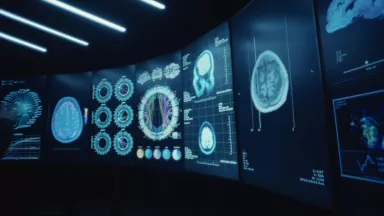The Stern Stroke Center at Montefiore

The Stern Stroke Center at Montefiore is a recognized leader in stroke services including state-of-the art acute and long-term management and preventative care. As a designated Advanced Comprehensive Stroke Center, Montefiore, The Stern Stroke Center identifies and treats victims of stroke rapidly and efficiently, offering immediate access to stroke specialists 24 hours a day, seven days a week.
The Stroke Team at Montefiore’s Comprehensive Center for Stroke is focused on providing the best possible stroke-related care during the COVID-19 pandemic. We are continuing to provide stroke care in the hospital and are supporting our outpatients with stroke prevention and healthy living strategies
- If you or someone around you is experience symptoms of a stroke we recommend that you call 911 immediately. Stroke symptoms include sudden:
- Balance problems
- Eye problems (double vision or trouble seeing in one or both eyes)
- Facial droop
- Arm or leg weakness or numbness
- Slurred speech or garbled speech including difficulty understanding speech
- Time to call 911
- One more thing – sudden severe headache (worst headache of your life) is also a symptom of a severe stroke and should prompt 911 activation.
- Remember to BE FAST when dealing with stroke. Call 911 immediately!!!
- To ensure the safety of our patients, our clinic visits will be done remotely for now. If you have a clinic appointment with a provider in the stroke department, please expect a phone call on the day of your appointment. Be aware that the call ID may be blocked. To update your contact number, call 718 920 6444.
For more information on COVID-19, please visit http://covid19.montefiore.org/
If you have non-urgent stroke related questions, call us at (718) 920-6444.
Sincerely,
Your stroke providers Daniel Antoniello, Kerri-Ann Bell, Natalie Cheng, Charles Esenwa, Daniel Labovitz, Ava Liberman, Taha Nisar, Kathryn Kirchoff, David Rahimian, Ida Rampersad, Tina Rolston-Duncan, Ainie Soetanto

The Center treats more than 1400 acute stroke patients per year, making it the second busiest stroke center in New York State.
Improving the Quality of Care for Stroke Patients
Stroke is the 5th leading cause of death and a leading cause of adult disability in the United States. Every 40 seconds in the United States, someone suffers a stroke, and every four minutes, someone dies of a stroke. At the Stern Stroke Center, we recognize that the quality of care that a patient receives immediately after a stroke makes all the difference. It's why we coordinate care with a range of Montefiore specialists on the stroke team, including:
- Stroke neurologists;
- Vascular neurosurgeons;
- Neurointerventional radiologists;
- Neuroanesthesiologists; and
- Rehabilitation specialists.
Superior Outcomes for Treatment of Ischemic Stroke
Ischemic stroke is caused by a blockage in a blood vessel in the brain. Some stroke patients can have the blockage removed with a procedure called thrombectomy, similar to the way we open blockages in the heart during a heart attack. For some patients with acute stroke, a thrombectomy (treatment with a catheter to open up the blocked blood vessel) can dramatically improve recovery. As soon as thrombectomy became standard of care for acute stroke in 2015, Montefiore stepped up and has grown to become one of the leading thrombectomy centers in the country.
CEA/CAS Performance
Carotid endarterectomy and carotid artery stenting are procedures to open cholesterol blockages that can cause stroke, but the procedures have some risk. From July 2021 through December 2022, Montefiore surgeons performed 51 carotid endarterectomy surgeries and placed 6 carotid artery stents in acute stroke patients with no 30-day post-procedure stroke complications or mortalities in any of the patients.
A Coordinated and Collaborative Approach to Care
A highly- skilled team evaluates each patient and devises a comprehensive, individualized plan of treatment. The Stern Stroke Center provides care for acute stroke, including the administration of tissue plasminogen activator (tPA) and advanced endovascular procedures.
Our inpatient team of doctors, nurses, rehabilitation specialists and social workers with expertise in the care of stroke patients seek to identify the patient’s stroke risk factors, maximize patient safety and ensure a smooth transition to outpatient rehabilitation and stroke prevention. Care starts in the emergency department and continues after the patient leaves the hospital.
We invite you to contact us for more information on how we collaborate with patients and members of their care team (physicians and rehabilitation specialists) to improve quality of life and reduce the chance of recurrent stroke.




